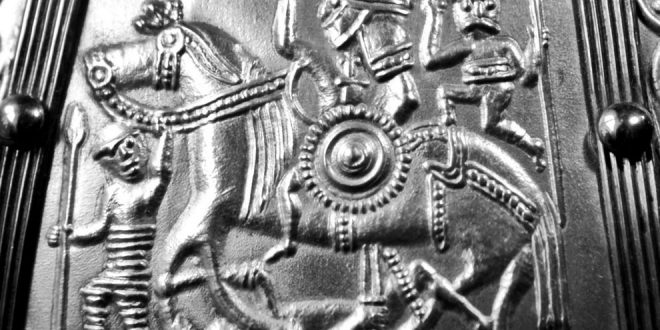A new discovery, just 30 miles west of London, may help transform historians’ understanding of the long process that led to the birth of England.
Archaeologists from the University of Reading have begun an investigation into a Dark Age military leader whose grave has been discovered on a hill overlooking the Thames near the Buckinghamshire town of Marlow.
Evidence from his skeleton, together with the grave goods buried with him, suggest that he was an elite individual, almost certainly a war band leader, perhaps an Anglo-Saxon chieftain or prince. For the first part of his military career, he would have been active during the era traditionally associated with the largely mythological military commander, King Arthur.
Careful excavation of the elite burial and ongoing analysis of the skeletal and other material in laboratories in Reading and Birmingham are gradually revealing his story.
“The discovery opens a window on a crucial period in which powerful tribes were starting to transform into kingdoms,” said Dr Gabor Thomas, the University of Reading archaeologist who directed the dig.
The warrior was buried, almost certainly dressed in fine garments, perhaps in the third quarter of the sixth century, accompanied by some of his most prized possessions – his 89cm double-bladed sword (still in its wood and leather scabbard), his knife and his presumably favourite feasting utensils – two very fine bronze bowls (both imported from what is now Belgium or France).
Other grave goods buried with him, included two spears, a beautiful 15 cm tall drinking beaker (made of very thin fine clear glass), a pair of bronze tweezers, a pair of iron scissors – and a 25cm long iron rod.
The grave – with its view over the Thames – was located just 17 miles east of the probable original Dorchester-on-Thames epicentre of the Kingdom of Wessex and just 14 miles east of a known early royal Wessex estate at Benson.
The discovery is of great importance because it will allow scientists to carry out detailed DNA, isotopic and other tests on a man who was almost certainly involved in the establishment of Anglo-Saxon power in the middle and upper Thames valley – and potentially in the birth of the Kingdom of Wessex that resulted from that complex political process.
Although Wessex was the Anglo-Saxon state which eventually, several centuries later, took control of England as a whole, its origins are still shrouded in mystery.
Popularly, it’s known as one of the many Anglo-Saxon kingdoms which existed for hundreds of years in England prior to the country’s unification in the 10th century – but, in origin, it was probably not a purely Anglo-Saxon political entity.
Some evidence suggests that its leaders were a mixture of individuals from very diverse ethnic groups – some from local Thames Valley British origins, others from continental Germanic origin and still others from possibly Irish origin.
Initially, the Kingdom of Wessex (literally the “Kingdom of the West Saxons”) was known as the Kingdom of the Gewisse – a Germanic word meaning “the trusted ones” or “those [warriors] who could be relied upon”.
It is likely that originally they were a group of probably Germanic-originating mercenaries who, after the collapse of Roman authority in Britain (in 410 AD), were recruited and employed by a local post-Roman fifth century native British ruler to help him maintain order. Indeed, they would have been the troops he would have had to “rely upon”.
At some stage the Gewisse appear to have been joined by other warriors – potentially including some of Irish ancestry.
However, most of the early kings of the Gewisse appear to have been of local British or at least partly British origin. Certainly their names, mentioned in the early part of the kingdom’s list of monarchs, suggest that most had British Celtic names – and a few had Irish Celtic names. But by the late seventh century, the kingdom’s monarchs bore exclusively Germanic-originating Anglo-Saxon names.
Now archaeologists are hoping that the Marlow warrior might be able to shed new light on the sort of military commanders who were establishing political control in and around proto-Wessex in the sixth century.
The combined evidence from his skeleton and his grave goods (and from other graves elsewhere along the middle and upper Thames) suggests that he was probably born into a wealthy (and therefore potentially powerful) family in or around the second decade of the sixth century.
It’s not yet known whether his family was of British or Germanic origin – but it is conceivable that he held land in the Marlow area.
Perhaps significantly, his burial place not only overlooks the Thames (a major Anglo-Saxon “highway”) but also a probable Roman villa, which (back in Roman times), like other villas may well have been the centre of an agricultural estate, which the Marlow warrior or his ancestors are likely to have either inherited or seized.
The muscle attachment evidence from his skeleton reveals that he was very well built – like a robust modern top-flight rugby player.
He was around six-foot tall (significantly taller than average for that period) – and would probably have weighed in at around 95 kg.
Although he was a warrior, he would not have been able to develop his huge biceps and other muscles, purely by fighting. It is therefore likely that he was involved in manual agricultural and other work – potentially even alongside people of much lower social status.
Evidence from his skeleton also suggests that he was a mounted warrior (rather than one who fought on foot). That would be consistent with the high status nature of his grave goods and his prominent and exclusive burial location.
It also chimes with a fascinating piece of evidence from his sword scabbard. Anglo-Saxon weapons expert, Matt Bunker, examined the bronze lower section of the scabbard (a component known as a chape) and found a probable sword impact mark on it (a 1.5 mm deep V-shaped indentation). That is precisely the sort of area that a sword-wielding enemy foot soldier might accidentally have hit while aiming to sever a mounted warrior’s left leg. It seems likely that the Marlow warrior, at least on that occasion, avoided very serious injury by just a few centimetres.
The skeletal evidence suggests that he finally perished (most likely from illness or in battle) at around the age of 50.
Taking all the available other evidence into account, he probably died at some stage in or around the third quarter of the sixth century.
That specific period was a particularly momentous era.
First, it was the time that the first known Plague pandemic devastated much of Europe – including parts of Britain. The disease killed very large numbers of people, thus creating demographic and political vacuums which, in turn, generated major geopolitical changes (probably including a renewed Anglo-Saxon advance westwards).
Secondly, it was the main era of Gewisse/Wessex warfare against the native British. Of the 11 battles/wars (mentioned in the Anglo-Saxon Chronicle) between 500 and 650, seven took place in the second half of the sixth century (although the Anglo-Saxon Chronicle only tends to mention Anglo-Saxon victories, not defeats!). It is conceivable that the Marlow warrior was involved in at least some of those major battles.
Thirdly, partly because of those Wessex victories, the kingdom of the Gewisse became a major political power in southern Britain in the later sixth century and early seventh century and (rebranded as Wessex) much later came to dominate and unite the whole of England.
The wars between Gewisse/Wessex and the native British at that period reveal that British political control still existed over substantial areas of what are now Buckinghamshire and Oxfordshire more than a century after the Anglo-Saxons had begun to dominate much of eastern and southern Britain. Indeed, it is known that British (Celtic/Welsh) speaking communities still survived in parts of eastern and southern Britain for many hundreds of years.
The Marlow warrior was initially discovered in 2018 by a history enthusiast, Sue Washington (a member of a local metal detectorist club, the Maidenhead Searchers) who immediately reported it to local archaeologists. However, the discovery was kept secret to protect the site.
A small archaeological excavation was carried out that year – with a much larger excavation (by the University of Reading) investigating the site over recent months. The excavation revealed an unusual funerary practice – the use of large numbers of flint nodules to cover the grave – possibly in the form of a cairn. Although the Marlow warrior’s shield was not buried with him, it is possible that it was placed on top of the cairn.
A full-scale laboratory analysis of the skeleton and the grave goods has now begun and, subject to funding availability, will continue into next year. A crowd-funding campaign has just been launched.
“The discovery provides an opportunity to carry out scientific research which will allow us to build up a detailed picture of the identity of this individual in the context of his time,” said Dr Thomas, associate professor of Early Mediaeval Archaeology at the University of Reading.
The Independent
 Lebanese Ministry of Information
Lebanese Ministry of Information



